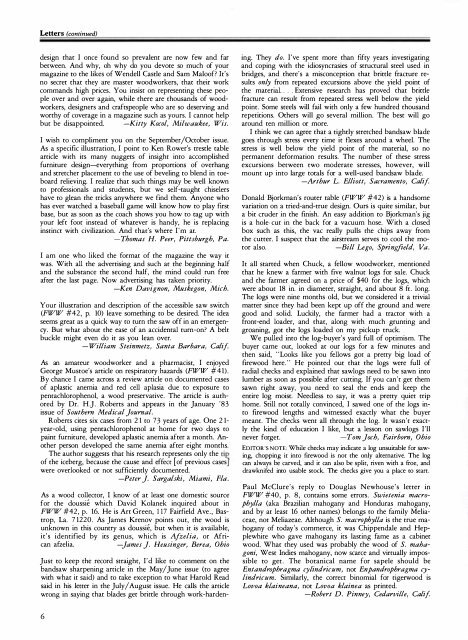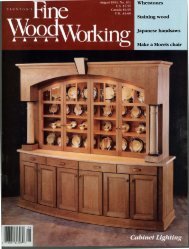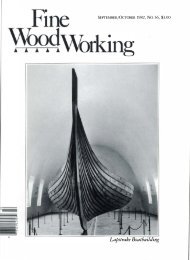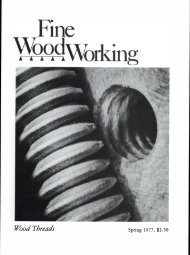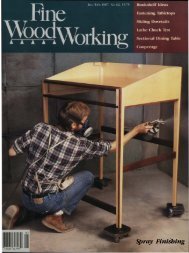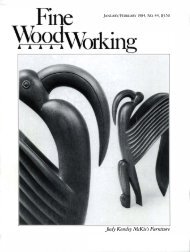NOVEMBER/DECEMBER 1983, No. 43, $3.50 Making ... - Wood Tools
NOVEMBER/DECEMBER 1983, No. 43, $3.50 Making ... - Wood Tools
NOVEMBER/DECEMBER 1983, No. 43, $3.50 Making ... - Wood Tools
You also want an ePaper? Increase the reach of your titles
YUMPU automatically turns print PDFs into web optimized ePapers that Google loves.
(continued)<br />
Letters<br />
design that I once found so prevalent are now few and far<br />
between. And why, oh why do you devote so much of your<br />
magazine to the likes of Wendell Castle and Sam Maloof? It's<br />
no secret that they are master woodworkers, that their work<br />
commands high prices. You insist on representing these people<br />
over and over again, while there are thousands of woodworkers,<br />
designers and craftspeople who are so deserving and<br />
worthy of coverage in a magazine such as yours. I cannot help<br />
but be disappointed. -Kitty Kocol, Milwaukee, Wis.<br />
I wish to compliment you on the September/October issue.<br />
As a specific illustration, I point to Ken Rower's trestle table<br />
article with its many nuggets of insight into accomplished<br />
furniture design-everything from proportions of overhang<br />
and stretcher placement to the use of beveling to blend in toeboard<br />
relieving. I realize that such things may be well known<br />
to professionals and students, but we self-taught chiselers<br />
have to glean the tricks anywhere we find them. Anyone who<br />
has ever watched a baseball game will know how to play first<br />
base, but as soon as the coach shows you how to tag up with<br />
your left foot instead of whatever is handy, he is replacing<br />
instinct with civilization. And that's where I'm at.<br />
-Thomas H. Peer, Pittsburgh, Pa.<br />
I am one who liked the format of the magazine the way it<br />
was. With all the advertising and such at the beginning half<br />
and the substance the second half, the mind could tun free<br />
after the last page. <strong>No</strong>w advertising has taken priority.<br />
-Ken Davignon, Muskegon, Mich.<br />
cy. But<br />
Your illustration and description of the accessible saw switch<br />
(FWW #42, p. 10) leave something to be desired. The idea<br />
seems great as a quick way to turn the saw off in an emergen<br />
what about the ease of an accidental turn-on? A belt<br />
buckle might even do it as you lean over.<br />
-William Steinmetz, Santa Barbara, Calif<br />
As an amateur woodworker and a pharmacist, I enjoyed<br />
George Mustoe's article on respiratory hazards (FWW #41).<br />
By chance I came across a review article on documented cases<br />
of aplastic anemia and red cell aplasia due to exposure to<br />
pentachlorophenol, a wood preservative. The article is authored<br />
by Dr. H.). Roberts and appears in the January '83<br />
issue of Southern Medical Journal.<br />
Roberts cites six cases from 21 to 73 years of age. One 21year-old,<br />
using pentachlorophenol at home for two days to<br />
paint furniture, developed aplastic anemia after a month. Another<br />
person developed the same anemia after eight months.<br />
The author suggests that his research represents only the til2 of<br />
FWW<br />
the iceberg, because the cause and effect [of previous cases J<br />
were overlooked or not sufficiently documented.<br />
-Peter ]. Sargalski, Miami, Fla.<br />
As a wood collector, I know of at least one domestic source<br />
for the doussie which David Kolanek inquired about in<br />
#42, p. 16. He is Art Green, 117 Fairfield Ave., Bastrop,<br />
La. 71220. As James Krenov points out, the wood is<br />
unknown in this country as doussie, but when it is available,<br />
it's identified by its genus, which is A/zelia, or African<br />
afzelia. -James ]. Heusinger, Berea, Ohio<br />
Just to keep the record straight, I'd like to comment on the<br />
band saw sharpening article in the May /J une issue (to agree<br />
with what it said) and to take exception to what Harold Read<br />
said in his letter in the July/August issue. He calls the article<br />
wrong in saying that blades get brittle through work-harden-<br />
6<br />
ing. They do. I've spent more than fifty years investigating<br />
and coping with the idiosyncrasies of sttuctural steel used in<br />
bridges, and there's a misconception that brittle fracture results<br />
only from repeated excursions above the yield point of<br />
the material. . .. Extensive research has proved that brittle<br />
fracture can result from repeated stress well below the yield<br />
point. Some steels will fail with only a few hundred thousand<br />
repetitions. Others will go several million. The best will go<br />
around ten million or more.<br />
I think we can agree that a tightly stretched bandsaw blade<br />
goes through stress every time it flexes around a wheel. The<br />
stress is well below the yield point of the material, so no<br />
permanent deformation results. The number of these stress<br />
excursions between two moderate stresses, however, will<br />
mount up into large totals for a well-used bandsaw blade.<br />
-Arthur L. Elliott, Sacramento, Calif<br />
Donald Bjorkman's router table (FWW #42) is a handsome<br />
variation on a tried-and-true design. OutS is quite similar, but<br />
a bit ctuder in the finish. An easy addition to Bjorkman's jig<br />
is a hole· cut in the back for a vacuum hose. With a closed<br />
box such as this, the vac really pulls the chips away from<br />
the cutter. I suspect that the airstream serves to cool the motor<br />
also. -Bill Lego, Springfield, Va .<br />
It all started when Chuck, a fellow woodworker, mentioned<br />
that he knew a farmer with five walnut logs for sale. Chuck<br />
and the farmer agreed on a price of $40 for the logs, which<br />
were about 18 in. in diameter, straight, and about 8 ft. long.<br />
The logs were nine months old, but we considered it a trivial<br />
matter since they had been kept up off the ground and were<br />
good and solid. Luckily, the farmer had a tractor with a<br />
front-end loader, and that, along with much grunting and<br />
groaning, got the logs loaded on my pickup truck.<br />
We pulled into the log-buyer's yard full of optimism. The<br />
buyer came out, looked at Out logs for a few minutes and<br />
then said, "Looks like you fellows got a pretty big load of<br />
firewood here." He pointed out that the logs were full of<br />
radial checks and explained that sawlogs need to be sawn into<br />
lumber as soon as possible after cutting. If you can't get them<br />
sawn right away, you need to seal the ends and keep the<br />
EDITOR·S<br />
entire log<br />
NOTE:<br />
moist. Needless to say, it was a pretty quiet trip<br />
home. Still not totally convinced, I sawed one of the logs into<br />
firewood lengths and witnessed<br />
be<br />
exactly what the buyer<br />
meant. The checks went all through the log. It wasn't exactly<br />
the kind of education I like, but a lesson on sawlogs I'll<br />
never forget. -Tom Joch, Fairborn, Ohio<br />
FWW<br />
While checks may indicate a log unsuitable for sawing,<br />
chopping it into firewood is not the only alternative. The log<br />
can always be carved, and it can also split, riven with a froe, and<br />
drawknifed into usable stock. The checks give you a place to start.<br />
Paul McClure's reply to Douglas Newhouse's letter in<br />
#40, p. 8, contains some errors. Swietenia macrophylla<br />
(aka Brazilian mahogany and Honduras mahogany,<br />
and by at least 16 other names) belongs to the family Meliaceae,<br />
not Meliazeae. Although S. macrophylla is the true mahogany<br />
of today's commerce, it was Chippendale and Hepplewhite<br />
who gave mahogany its lasting fame as a cabinet<br />
wood. What they used was probably the wood of S. mahagoni,<br />
West Indies mahogany, now scarce and virtually impossible<br />
to get. The botanical name for sapele should be<br />
Entandrophragma cylindricum, not Enpandrophragma cylindricum.<br />
Similarly, the correct binomial for tigetwood is<br />
Lovoa klaineana, not Lovoa klainea as printed.<br />
-Robert D. Pinney, Cedarville, Calif


